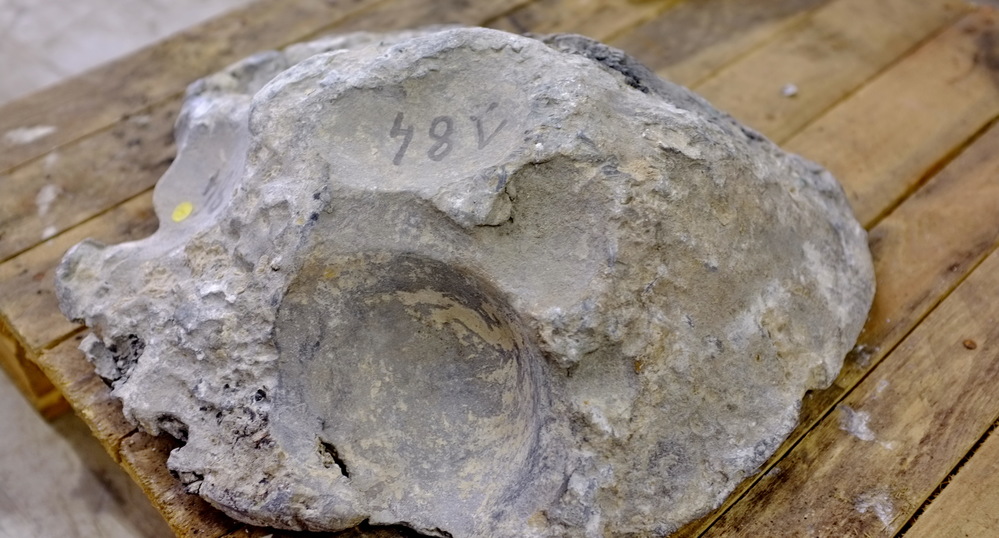Ancient Rome and elementary particles
Scientists of NUST “MISiS” with the help of new technology measured the amount of trace elements in the ingots of antique lead from a sunken ship of the ancient Romans. It turned out that lead, lying for 1,500 years under the water column, contains so few radioactive elements - uranium and thorium that it can be used without any additional purification in one of the most "demanding" areas - nuclear physics - the study of elementary particles. The experiment on the identification and determination of trace elements was carried out in collaboration with colleagues from the Joint Institute for Nuclear Research (Dubna) and the National Center for Scientific Research (France).

The more accurate and productive modern devices become, the more pure chemicals are required for their manufacture. These are the so-called “especially pure substances” (OHS) - which contain impurities in such an insignificant amount that they do not affect the basic specific properties of the studied objects. One of the most “demanding” areas of application of the FFA is the experimental physics of elementary particles. For example, for charged particle accelerators, which are already built underground to protect against cosmic rays, additional protection against radiation from special shields made of ultrapure lead is still required. One example of such accelerators is the Large Hadron Collider CERN.
Obtaining very pure lead takes place in several stages, such as dissolving the ore, smelting, separating the alloy into its constituent parts, cleaning with alkali, and the sequential separation of each impurity substance. After many stages of purification, a sample of very pure lead needs to be analyzed. The maximum permissible impurity of radioactive elements should be no more than 0.0000000001% (one ten billionth) of the total mass. With such a quantity of radioactive impurities and below, lead can be used to protect high-precision devices. However, even the most modern methods of direct elemental analysis do not allow one to determine such small amounts of impurities against the background of the main component, lead.

A fragment of a lead ingot found in the skeleton of an ancient Roman ship off the coast of France
Scientists at the separation and concentration laboratory in the chemical diagnostics of functional materials and environmental objects of NUST “MISiS” under the supervision of Dr. Sc. Peter Fedotov proposed a new method of separating impurities for their subsequent analysis. The experiment was conducted on samples of antique lead - ingots older than 1500 years. This lead was once mined by the ancient Romans in mines located on the territory of modern England. When transporting lead ore, the ship sank, and was discovered only at the end of the 20th century off the coast of France.
At the time of the experiment, this lead had been used by the National Center for Scientific Research (France) for several years as a highly pure substance - over a thousand and a half years, a substantial part of uranium and thorium naturally decayed, and the water column protected lead ingots from “sticking” new radioactive impurities. Uranium and thorium were not detected in this lead, however, it was assumed that the amount of impurities could simply be lower than the level of “visibility” of direct instrumental analysis, that is, below 0.00000001% (one hundred millionth).
Then the scientists of NUST “MISiS” proposed their own method of separating impurities for subsequent analysis. Using a so-called planetary centrifuge and a system of two immiscible liquids (water and chloroform) containing special reagents, they first dissolved the lead sample in especially pure nitric acid, and then the impurities were isolated and concentrated.

Planetary centrifuge
Such a combined approach, based on the separation of impurities and their subsequent determination, allowed scientists of NUST “MISiS” to determine the impurities of uranium and thorium with the required accuracy of 0.0000000001% (one ten billionth). However, the content of uranium and thorium was below this level. Thus, it turns out that antique lead, mined by the ancient Romans and raised from the sea only 1,500 years later, is so clean that even with the most accurate methods for separating and analyzing impurities, they cannot be seen and measured.
Scientists of NUST “MISiS” plan to use their new system for separating impurities in a planetary centrifuge in the future, mainly for the analysis of TFA.
Article published in Talanta magazine .

Photo by RIA Novosti

The more accurate and productive modern devices become, the more pure chemicals are required for their manufacture. These are the so-called “especially pure substances” (OHS) - which contain impurities in such an insignificant amount that they do not affect the basic specific properties of the studied objects. One of the most “demanding” areas of application of the FFA is the experimental physics of elementary particles. For example, for charged particle accelerators, which are already built underground to protect against cosmic rays, additional protection against radiation from special shields made of ultrapure lead is still required. One example of such accelerators is the Large Hadron Collider CERN.
Obtaining very pure lead takes place in several stages, such as dissolving the ore, smelting, separating the alloy into its constituent parts, cleaning with alkali, and the sequential separation of each impurity substance. After many stages of purification, a sample of very pure lead needs to be analyzed. The maximum permissible impurity of radioactive elements should be no more than 0.0000000001% (one ten billionth) of the total mass. With such a quantity of radioactive impurities and below, lead can be used to protect high-precision devices. However, even the most modern methods of direct elemental analysis do not allow one to determine such small amounts of impurities against the background of the main component, lead.

A fragment of a lead ingot found in the skeleton of an ancient Roman ship off the coast of France
Scientists at the separation and concentration laboratory in the chemical diagnostics of functional materials and environmental objects of NUST “MISiS” under the supervision of Dr. Sc. Peter Fedotov proposed a new method of separating impurities for their subsequent analysis. The experiment was conducted on samples of antique lead - ingots older than 1500 years. This lead was once mined by the ancient Romans in mines located on the territory of modern England. When transporting lead ore, the ship sank, and was discovered only at the end of the 20th century off the coast of France.
At the time of the experiment, this lead had been used by the National Center for Scientific Research (France) for several years as a highly pure substance - over a thousand and a half years, a substantial part of uranium and thorium naturally decayed, and the water column protected lead ingots from “sticking” new radioactive impurities. Uranium and thorium were not detected in this lead, however, it was assumed that the amount of impurities could simply be lower than the level of “visibility” of direct instrumental analysis, that is, below 0.00000001% (one hundred millionth).
Then the scientists of NUST “MISiS” proposed their own method of separating impurities for subsequent analysis. Using a so-called planetary centrifuge and a system of two immiscible liquids (water and chloroform) containing special reagents, they first dissolved the lead sample in especially pure nitric acid, and then the impurities were isolated and concentrated.

Planetary centrifuge
Such a combined approach, based on the separation of impurities and their subsequent determination, allowed scientists of NUST “MISiS” to determine the impurities of uranium and thorium with the required accuracy of 0.0000000001% (one ten billionth). However, the content of uranium and thorium was below this level. Thus, it turns out that antique lead, mined by the ancient Romans and raised from the sea only 1,500 years later, is so clean that even with the most accurate methods for separating and analyzing impurities, they cannot be seen and measured.
Scientists of NUST “MISiS” plan to use their new system for separating impurities in a planetary centrifuge in the future, mainly for the analysis of TFA.
“Among the advantages of the technology we have proposed is its“ flexibility ”: depending on the impurities of which elements need to be separated, a variety of reagents and immiscible liquid phases can be used. Thus, it is possible to separate, concentrate, and analyze the smallest ultra-trace impurities to determine the “high purity” of substances, ”says Petr Fedotov, the head of the study.In addition, potentially with large volumes of the separation column of the planetary centrifuge, it is possible to purify substances in this way - by dissolving them and driving them through the cycle of separation of impurities.
Article published in Talanta magazine .

Photo by RIA Novosti
